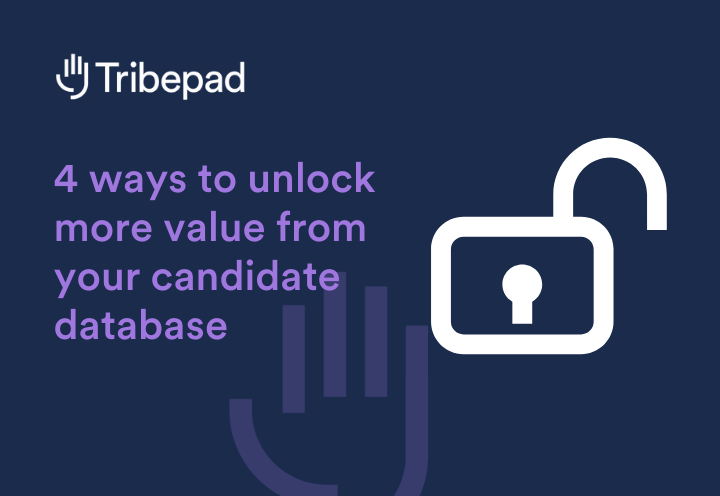Imagine spending millions of pounds on one amazing asset that offers a completely unique competitive advantage to your organisation. And then imagine letting it gather dust.
That’s what many recruitment teams are doing with their candidate database. You can unlock value from your biggest asset by searching better, nurturing talent pools, calling ‘stale’ CVs, and consistently training your recruiters.
Recruitment’s come a long way over the past decade, with an endless array of helpful automations, seamless integrations, and digital-first functions. Those developments are extremely valuable – but there’s an even more powerful weapon in your armoury, and most recruiters neglect it:
Your candidate database.
We know, a database isn’t as exciting as snazzy new campaign management tools or flawless onboarding. But your candidate database is your biggest – and often, most underused – resource.
It’s a private internal asset you’ve spent years – and hundreds of thousands of pounds (at least) – building. Your candidate database shouldn’t be a graveyard where CVs go to die. It shouldn’t be a last resort, that your recruiters begrudgingly search after exhausting job boards, social media, and agencies.
If you use it right, your database can be a thriving matrix of living information with millions – even tens of millions – of warm leads. Used right, your database is the key to recruiting faster, improving quality of hire, building your talent pipeline, and slashing recruitment costs.
That’s the dream, right? Here’s how to realise it.
How to get more value from your ATS candidate database
1 – Search better
Most applicant tracking systems (ATS) have notoriously bad search functionality. Especially compared to the advanced search available on major job board databases.
That’s a major issue.
As Glen Cathey of Boolean Black Belt Sourcing/Recruiting puts it, “Having an ATS/CRM/candidate database that is not highly searchable is like putting your money into an insolvent financial institution. You can deposit money/assets in – but you can’t easily or reliably make withdrawals. The bottom line is that data has no value if you can’t retrieve it.”
To unlock value from your candidate database, your ATS must facilitate advanced precision search – and your team should be confident using the full functionality.
If they’re not, schedule training (either internally led by superusers or with your tech provider) to make sure you’re getting the most from your investment. And if your database doesn’t offer advanced search, it might be time to research new recruitment software providers.
Talent Search is an extremely rich part of the Tribepad talent acquisition platform. It empowers recruiters to surface best-fit candidates fast with advanced search including Boolean strings, saved searches, comprehensive filtering, and AI-powered candidate suggestion.
2 – Build and nurture talent pools
Here’s an unwieldy metaphor for you. Imagine your database is a garden and successful hires are flowers. Either you can litter your garden with shiny artificial cacti, or you can plant a whole bunch of living, breathing, CO2 guzzling plants.
The former might be easier (no upkeep! Essentially dead!) but the latter is the only option that’ll bloom.
In other words, if you treat your database like a static, passive CV repository then it won’t add much value. But if you water it – proactively sourcing and segmenting new candidates into talent pools then nurturing them – you’ll wind up with a Chelsea Flower Show worthy display.
One valuable tactic is to build talent pools of your silver and bronze medallists – the candidates you interviewed who were fantastic and left a great impression, but just missed out on the job. Next time you’re hiring, here’s where you stop first.
The quickest way to nurture candidates is through recruitment campaigns, so you’ll need recruitment tech with robust CRM functionality. Make sure you collect permission to contact candidates for future roles though, to stay GDPR-compliant.
3 – Call your ‘stale’ CVs
Recruitment campaigns might be the quickest way to nurture your database, but they’re not the only way. It’s also sometimes worth taking a little longer and calling candidates for a quick catch-up.
Glen Cathey makes an extremely good point, that contrary to popular opinion CVs don’t lose value over time. He calls this the “time value of CVs” – where old CVs actually become more valuable, because they give you access to candidates who’ve probably become passive since last posting a CV or updating their LinkedIn.
No, you won’t know from an outdated CV whether someone’s a good fit today – but if they were great, there’s a good bet they’re still great. And often, they’ll have stuck to a fairly predictable career path.
A short phone call to maintain the relationship gives you information no other recruiter (likely) has.
At the least, you’ll have up-to-date info to update your records with (crucial to keeping your database clean). But at the best, you could discover a passive candidate nobody else has spoken to. It unlocks a whole channel of hidden passive talent – and cements your relationship for the long-haul. So when that great candidate is ready to consider a move, it’s you they talk to.
4 – Upskill your recruiters
Ultimately, your candidate database is only as good as your recruitment team.
Your recruiters write the job adverts that attract candidates. They decide which candidates to add to your database directly. They check for duplicate profiles and delete (or don’t). They check parsing and correct important mistakes (or don’t). They add notes and feedback (or don’t). They search your database before opening roles to agencies (or don’t).
Your ATS can do much to help – like sophisticated parsing; automatic CV formatting; duplicate entry warnings; bulk editing; process and permissions automations – but there’s no getting around the importance of recruiter behaviour.
Identify where your process issues are – then train accordingly.
- Do your recruiters need Boolean search training?
- Do they need training to write better ads, to attract better candidates?
- Do they need processes mandating, like searching your database first?
- Do they need tags standardising globally, for consistency?
Keep your candidate database clean and turn it into an asset the entire organisation can use. That’s especially valuable for global recruitment teams or multi-brand teams. An underlying unified database is one of the biggest assets your organisation can have, provided processes and governance about how teams use it.
Are you missing an open goal?
Your candidate database is the most powerful tool at your team’s fingertips.
For all the exciting advancements in the recruitment software space, transforming your recruitment can often start with something much more basic.
If you’re not already maximising value from your team’s biggest asset, now’s the time to turn that around.
Tribepad Core ATS + CRM is the heart of our powerfully straightforward enterprise talent acquisition software. Learn more here.




